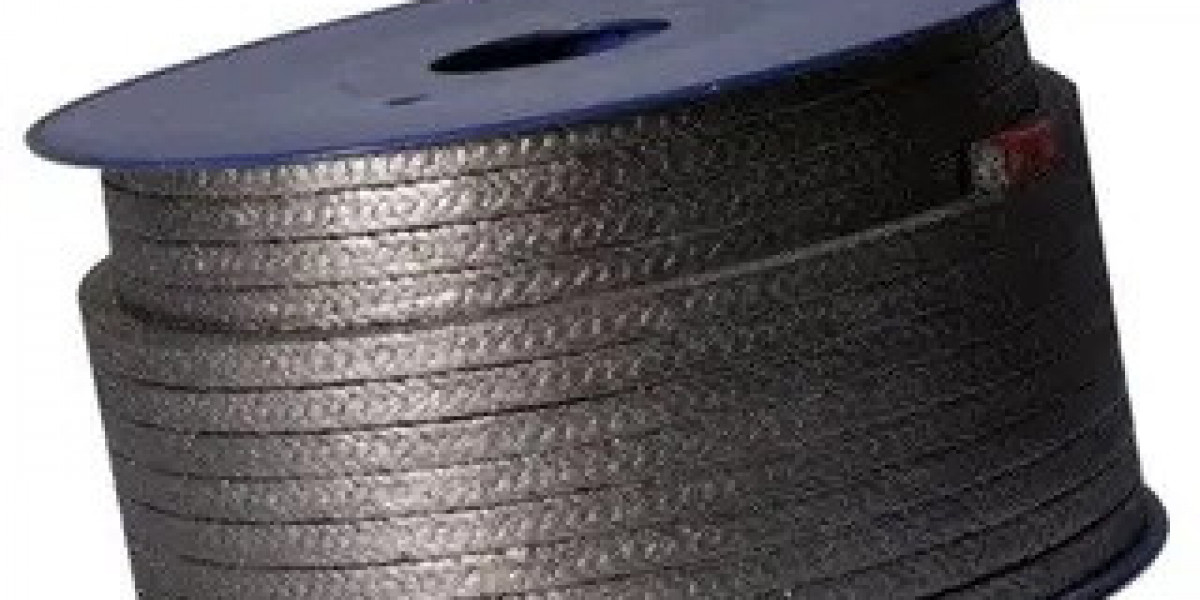In industrial operations, the choice of sealing materials plays a decisive role in ensuring the stability and safety of equipment. Among the various sealing materials available, expanded graphite packing—renowned for its unique properties and extensive applicability—has become a preferred solution for many enterprises. This article provides a detailed overview of its properties, advantages, limitations, and best practices for installation and maintenance, helping users maximize its performance and reliability.
Properties of Expanded Graphite Packing
Expanded graphite packing, also known as flexible graphite packing, is produced by braiding flexible graphite yarns. The material preserves the outstanding chemical stability of natural flake graphite while introducing enhanced mechanical performance. Expanded graphite is created by chemically treating high-quality flake graphite and expanding it rapidly at high temperatures. It possesses the following key features:
Low Density and High Plasticity: With a bulk density of only 0.002–0.005 g/cm³ and product density ranging from 0.8–1.8 g/cm³, expanded graphite is lightweight and highly formable, making it suitable for processing into various sealing shapes and configurations.
High Purity: The carbon content typically reaches 98% or higher, even exceeding 99% in some grades, meeting the demanding purity requirements of fields such as nuclear energy and aerospace.
Wide Temperature Resistance: Expanded graphite remains stable across an exceptional temperature range—from -200℃ up to 3000℃ in theory. In practical use as packing, it performs reliably between -200℃ and 800℃, maintaining flexibility at low temperatures and resisting deformation or decomposition under heat.
Excellent Chemical Resistance: With strong inertness, expanded graphite resists corrosion from most media including acids, alkalis, seawater, steam, and solvents—except in contact with strong oxidizers like nitric acid, sulfuric acid, aqua regia, or halogens under certain conditions.
Superior Thermal Conductivity and Low Thermal Expansion: Its thermal conductivity and expansion coefficients are similar to those of common sealing materials, ensuring consistent sealing performance under extreme or fluctuating temperatures.
Radiation Resistance: Expanded graphite endures prolonged exposure to neutron and gamma radiation without significant degradation.
Low Permeability: Its high surface energy facilitates the formation of tight films that effectively prevent gas or liquid penetration.
Self-Lubrication: Retaining graphite’s layered hexagonal structure, the material’s layers slide easily under pressure, reducing friction and preventing shaft or valve stem wear.
Ease of Processing: With low hardness, expanded graphite can be cut, wound, or formed easily using standard tools.
Thanks to these attributes, expanded graphite packing has become a highly adaptable and effective sealing material across diverse industrial sectors.
Advantages of Expanded Graphite Packing
Expanded graphite packing stands out among sealing materials due to several outstanding benefits:
Excellent Self-Lubrication and Heat Transfer: Its natural lubricity minimizes shaft friction and wear, while high thermal conductivity ensures rapid heat dissipation, protecting components from localized overheating.
Low Friction and Broad Compatibility: Its low friction coefficient and adaptability make it suitable for various equipment types and operational environments.
High Strength and Flexibility: Combining softness with tensile strength, it can conform to irregular sealing surfaces while withstanding pressure and mechanical stress.
Shaft Protection: Its softness and lubricating qualities protect shafts from scoring, corrosion, or deformation.
Customizability: To meet specific operational requirements, it can be reinforced with carbon fiber, copper wire, stainless steel (304/316L), or Inconel wire for enhanced corrosion or high-temperature resistance.
Disadvantages of Expanded Graphite Packing
Despite its strengths, expanded graphite packing has certain limitations:
Variable Sealing Stability: Sealing effectiveness may fluctuate under varying temperatures and pressures. In extreme high-temperature or high-pressure environments, leakage may occur if not properly maintained.
Limited Service Life: Susceptibility to wear and aging can reduce operational longevity, especially in harsh conditions—necessitating periodic replacement and maintenance.
Complex Installation and Maintenance: Installation requires skilled handling and precision tools. Improper fitting can lead to sealing failure or damage, particularly under challenging conditions.
Applications of Expanded Graphite Packing
Because of its versatility, expanded graphite packing is widely applied in petroleum, chemical, power generation, and pharmaceutical industries. It is used for both static and dynamic seals in valves, pumps, and pipeline joints. Whether in high-temperature steam systems or corrosive chemical transport lines, it ensures reliable sealing and safe, continuous operation.
Installation Guidelines for Expanded Graphite Packing
Performance reliability depends heavily on correct installation and maintenance. Improper handling can compromise sealing and lead to equipment failure. The following guidelines help ensure optimal installation:
Preparation Before Installation
Remove Old Packing: Use a packing extractor to remove all remnants without scratching equipment surfaces.
Clean the Stuffing Box: Thoroughly clean the stuffing box to eliminate debris and residue.
Inspect Components: Check shafts, rods, and associated parts for wear, corrosion, or damage. Replace defective components as needed.
Failure Analysis: Examine worn packing to identify causes of failure and prevent recurrence.
Accurate Measurement: Record shaft diameters, stuffing box dimensions, and depth to calculate the correct cross-section and ring quantity.
Selecting Appropriate Packing
Choose packing that matches equipment specifications and working conditions. Inspect for visible defects before installation.Installation Process
Prepare Tools: Use ring cutters, torque wrenches, calipers, lubricants, mirrors, and safety gear.
Insert Packing Rings: Place each ring individually, ensuring staggered joints to prevent leakage paths.
Pre-Tighten Gland Nuts: Apply even torque to achieve uniform compression without overtightening.
Adjustment and Inspection
Initial Adjustment: Allow limited leakage during startup and gradually tighten to achieve optimal sealing.
Stable Operation: Avoid overtightening once acceptable leakage is achieved; loosen slightly if leakage stops abruptly to prevent overheating.
Routine Checks: Inspect gland adjustments after a few hours of operation. Replace packing if adjustment limits are reached or damage is evident.
Conclusion
Expanded graphite packing remains a critical component in industrial sealing due to its combination of flexibility, thermal conductivity, lubricity, and mechanical strength. While it presents challenges such as limited lifespan and sensitivity to installation quality, these can be effectively managed through proper selection, skilled installation, and routine maintenance. When applied correctly, expanded graphite packing significantly enhances sealing performance, reduces operational risks, and ensures the safe, stable, and efficient operation of industrial systems—making it one of the most valuable sealing solutions in modern engineering.
It's important to know about Google SEO to help your website rank higher in search results.














